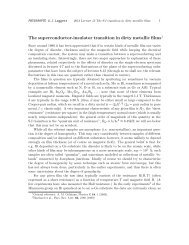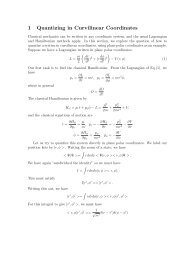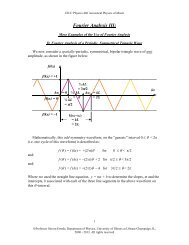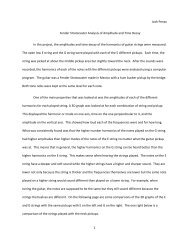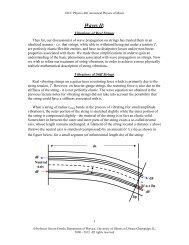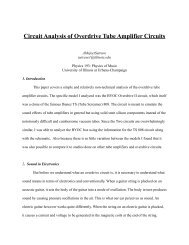Triode Vacuum Tube Laboratory Development - University of Illinois ...
Triode Vacuum Tube Laboratory Development - University of Illinois ...
Triode Vacuum Tube Laboratory Development - University of Illinois ...
Create successful ePaper yourself
Turn your PDF publications into a flip-book with our unique Google optimized e-Paper software.
<strong>Triode</strong> <strong>Vacuum</strong> <strong>Tube</strong> <strong>Laboratory</strong> <strong>Development</strong><br />
Noam D. Pikelny, Advisor: Steven Errede<br />
Department <strong>of</strong> Physics, <strong>University</strong> <strong>of</strong> <strong>Illinois</strong> at Urbana-Champaign<br />
1110 West Green Street, Urbana, IL 61801-3080, USA<br />
I present a detailed description <strong>of</strong> laboratory experiments and apparatus designed to aid students<br />
in research and understanding <strong>of</strong> Dual <strong>Triode</strong> <strong>Vacuum</strong> <strong>Tube</strong>s. Students will utilize the new<br />
laboratory setups in a new UIUC Physics Course 398 EMI, The Physics <strong>of</strong> Electronic Musical<br />
Instruments.<br />
WHY STUDY VACUUM TUBES<br />
In the past, the vacuum tube was a common<br />
household item. Early televisions, radios, and calculators<br />
utilized vacuum tubes. However, the invention <strong>of</strong> the<br />
transistor practically eliminated the use <strong>of</strong> vacuum tubes in<br />
almost all applications. Despite the advantages <strong>of</strong> solid-state<br />
technology such as size, reliability and cost, the vacuum<br />
tube is still used today in high-end audio applications. <strong>Tube</strong><br />
amplifiers produce a wonderfully warm tone that has not yet<br />
been successfully emulated through digital technology. This<br />
is one <strong>of</strong> the several reasons <strong>of</strong> why it is important to study<br />
vacuum tubes. It is obvious that a better understanding <strong>of</strong><br />
vacuum tubes is required to achieve the same sound with<br />
digital signal processing. The accepted standard data and<br />
parameters for vacuum tubes were recorded almost a halfcentury<br />
ago, before the invention <strong>of</strong> a calculator. Therefore,<br />
using today’s computers to study the characteristics <strong>of</strong><br />
tubes will yield a better understanding, and possibly more<br />
accurate parameters then those that have been widely<br />
accepted for years. Through this approach students will also<br />
learn how to use computer s<strong>of</strong>tware and hardware for data<br />
acquisition. Due to the dominance <strong>of</strong> transistors over tubes<br />
in society, vacuum tube technology is not always included<br />
in today’s physicist/engineer’s curriculum. Studying tube<br />
guitar amplifiers provides a more exciting way for students<br />
to learn tube theory than the standard textbook approach.<br />
P398EMI: The Physics <strong>of</strong> Electronic Musical<br />
Instruments<br />
The vacuum tube is not the only interesting aspect<br />
<strong>of</strong> electric musical instruments. Physical phenomena<br />
involving electric guitar pickups, loudspeakers,<br />
transformers, effects boxes, guitar body resonances, and<br />
more are all worthy <strong>of</strong> academic study. This long list <strong>of</strong><br />
interesting topics to investigate motivated Pr<strong>of</strong>essor Steve<br />
Errede to create a new physics course on the physics <strong>of</strong><br />
electronic musical instruments. The course will be taught for<br />
the first time this Fall 2000 semester at the <strong>University</strong> <strong>of</strong><br />
<strong>Illinois</strong> at Urbana-Champaign. Due to the fact that this will<br />
be the first <strong>of</strong>fering <strong>of</strong> the course, and that there are few<br />
courses on Electronic Musical Instruments being taught<br />
worldwide, much work and time is being spent deciding on<br />
issues such as the how to structure the course, and how<br />
much time is devoted to each topic. As a participant in NSF<br />
Research for Undergraduates program I worked on<br />
preparing laboratory experiments and apparatus for the<br />
course this fall. This included the following:<br />
1. Designing and building hardware<br />
2. Configuring standard laboratory equipment<br />
3. Writing graphical s<strong>of</strong>tware for data acquisition and<br />
analysis.<br />
4. Writing student lab manuals with background<br />
information, detailed instructions and sample results.<br />
VACUUM TUBE OPERATION<br />
The first vacuum tube device was the vacuum tube<br />
diode. It contained two active elements, the cathode and the<br />
anode/plate (Fig 1).<br />
FIG 1. <strong>Vacuum</strong> <strong>Tube</strong> Diode<br />
The vacuum tube operates through thermionic emission.<br />
The filament, also known as the heater, heats the cathode<br />
until the electrons acquire enough energy and boil <strong>of</strong>f the<br />
surface <strong>of</strong> the cathode, forming a space charge. The cathode<br />
is typically made out <strong>of</strong> tungsten. When the plate is held at a<br />
high positive potential with respect to the cathode, current<br />
will flow from the cathode to the plate. Many consider that<br />
the discovery <strong>of</strong> this effect sparked the birth <strong>of</strong> modern<br />
electronics. The vacuum diode presented a method <strong>of</strong><br />
rectification. The vacuum diode’s ability to block negative<br />
voltages, and conduct only in the presence <strong>of</strong> positive<br />
voltage provided a way to rectify alternating voltages.<br />
Although the vacuum diode was a major scientific<br />
breakthrough, a third active element was required to be able<br />
to amplify a signal. In the vacuum tube diode, there was no
way <strong>of</strong> controlling the amount <strong>of</strong> current flow in the tube. It<br />
was either conducting, or not conducting. In 1907 Lee<br />
Deforest added the grid to the vacuum tube diode, creating a<br />
vacuum tube with three active elements, the triode (Fig 2).<br />
Fig. 2 <strong>Vacuum</strong> <strong>Tube</strong> <strong>Triode</strong><br />
It was found that if the grid was held negative with respect<br />
to the cathode, it would limit the electron flow from the<br />
cathode to the plate. The grid acts as a valve that reduces<br />
current as it becomes more negative. A sufficient negative<br />
grid voltage will put the triode in its cut<strong>of</strong>f condition, where<br />
no current will flow. Maximum current will flow when the<br />
grid is at 0 volts.<br />
If a resistance is placed between the plate and the<br />
high voltage supply, a varying anode current will produce a<br />
proportional varying voltage drop across the resistance. Just<br />
a small change in grid voltage will produce a large variation<br />
at the plate. The triode effectively amplifies the grid voltage.<br />
The amount <strong>of</strong> gain (amplification) is then determined by<br />
the change in plate voltage for a given change in grid<br />
voltage.<br />
The triode will amplify an AC signal on the grid<br />
without any change in frequency. However, phase shift will<br />
occur. In fact, knowing the phase shift between the input<br />
and output <strong>of</strong> a triode is important in understanding the<br />
triode’s response to different input frequencies.<br />
VACUUM TUBE TRIODE EXPERIMENTS<br />
Most tube guitar amplifiers rely on vacuum tube<br />
triodes for pre-amplification, and driving certain sections<br />
such as a spring reverb, tone controls, or tremolo. In some<br />
classic guitar amplifiers, one can find as many as five dual<br />
triode vacuum tubes in use. Understandably, the properties<br />
and response <strong>of</strong> the vacuum tube triode have a great effect<br />
on the tone <strong>of</strong> an amplifier. We wanted to provide the<br />
students with an opportunity to research different types,<br />
brands and eras <strong>of</strong> triodes. We wanted to create a convenient<br />
way to investigate triodes and display the data graphically.<br />
Our goal was to have two different experiments for<br />
studying the triodes. Our first experiment, named<br />
TRIOPAR, (short for <strong>Triode</strong> Parameters) would be used for<br />
studying the tube parameters with static dc input. The<br />
students will be able to graph the results and compare to<br />
previously published values. The second experiment, named<br />
TRIOAMP (short for <strong>Triode</strong> Amplifier), would be used for<br />
studying the tube characteristics when acting as a voltage<br />
amplifier, with ac input. Before presenting the details <strong>of</strong><br />
each setup, it is worthwhile to present the setup information<br />
that is common to both TRIOPAR and TRIOAMP<br />
experiments.<br />
GENERAL SETUP FOR TRIOPAR AND TRIOAMP<br />
At the heart <strong>of</strong> both the TRIOPAR and TRIOAMP<br />
setups are modules that house the triode vacuum tube and<br />
circuitry (Fig 3). Each module is made out <strong>of</strong> an aluminum<br />
“bud”- type box.<br />
Fig. 3 TRIOPAR Module<br />
It was debated whether a clear plastic box should be used<br />
instead <strong>of</strong> aluminum because <strong>of</strong> the benefit <strong>of</strong> being able to<br />
view the circuit “through a window”. However, we decided<br />
to use the aluminum box because <strong>of</strong> its ability to shield the<br />
circuit and prevent noise. Since the modules are to be used<br />
in an undergraduate laboratory, safety was a main priority<br />
when designing the modules. For this reason, the high<br />
voltage plate supply uses SHV connectors. The<br />
filament/heater supply uses 3-pin Molex connectors. For all<br />
other connections, gold SMB connectors are used. The SMB<br />
connectors are much more resistant to corrosion and will<br />
provide the module a longer lab life then typical BNC or<br />
Phono connectors. Shielded SMB cable is used for all<br />
connections. The triode sits in a 9-pin tube socket mounted<br />
on the top <strong>of</strong> the module. The tube shield is used during all<br />
experiments to prevent noise.<br />
A National Instruments PC+ Card is used for data<br />
acquisition and control. The PC+ Card contains 8 Analogto-Digital<br />
Converters (ADC), and 2 Digital-to-Analog<br />
Converters (DAC). There also 24 standard TTL in and out<br />
lines available. We use the PC+ Card for controlling a<br />
Bertan 815 variable power supply. The Bertan has a<br />
maximum 500 V, 200 mA output. The voltage output is<br />
controlled by a 0-5 V signal from a DAC on the PC+ card.<br />
Dell computers with Pentium processors are used<br />
for each setup. We use the C programming language in<br />
LabWindows/CVI 5.0 to control the PC+ card for data<br />
acquisition and analysis.<br />
TrioPar: <strong>Triode</strong> Parameters Experiment and Setup<br />
Two main graphs have traditionally been included<br />
as part <strong>of</strong> a triode’s data sheet published by the manufacture.<br />
The first is a graph <strong>of</strong> Plate Current vs. Grid Voltage. This<br />
graph is obtained when the plate voltage is set to a constant<br />
high voltage (50 -300 V), and the plate current is measured<br />
for different grid voltages ( –5 V - 0V). A family <strong>of</strong> these
grid curves is obtained by repeating the test for different<br />
plate potentials (0- 300 V).<br />
The second graph is <strong>of</strong> Plate Current vs. Plate<br />
Voltage. This graph is obtained when the grid voltage is set<br />
to a constant (-.5 - -3.0 V), and the plate current is<br />
measured for different plate voltages (0 – 300 V). A family<br />
<strong>of</strong> these plate curves is obtained by repeating the test for<br />
different grid potentials (-.5 - -3.0V).<br />
The goal <strong>of</strong> the TRIOPAR Lab experiment is to<br />
obtain the Grid and Plate Family Graphs and to compare<br />
these to published values, and then possibly to utilize in new<br />
amplifier designs. From the two graphs, one can decide<br />
whether the tube is appropriate for the design, and decide<br />
what range <strong>of</strong> operation should be used.<br />
Traditionally, the current flowing through the tube<br />
(plate current) is obtained by measuring the voltage drop<br />
across a resistor tied to the plate. However, the cathode<br />
current is equal to plate current. This voltage drop across a<br />
cathode resistance is equivalent to the plate voltage.<br />
Because it is safer to measure the voltage at the cathode, in<br />
this experiment, we place no resistance between the plate<br />
and the +HV supply. Instead, a 1 Ohm resistor is placed in<br />
series with the cathode (Fig. 5). Throughout the experiment<br />
an ADC reads the voltage across the 1 ohm resistor. Since<br />
V= IR, the voltage reading in mV corresponds to the<br />
cathode current in mA.<br />
For the TRIOPAR setup, DAC 0 controls the<br />
Bertan which supplies the plate voltage. DAC 1 on the PC+<br />
card controls both grid voltages, and ADC’s 2 and 3 digitize<br />
the voltage across both cathode resistors for obtaining<br />
cathode 1 and 2 currents. A block diagram can be seen in<br />
figure 6.<br />
Grid Voltage vs. Cathode Current:<br />
Obtaining The Grid Family <strong>of</strong> Curves<br />
We first set the plate voltage at 50 V. The grid<br />
voltage is set at –5 volts. We step the grid voltage from –5.0<br />
V to –0.5 V in 0.01 V increments. At each point, the ADC’s<br />
take 1000 samples <strong>of</strong> the voltage across the 1 Ohm cathode<br />
resistor. When this is completed, we increase the voltage by<br />
50 V, and run the test again. This happens a total <strong>of</strong> six<br />
times (50, 100, 150, 200, 250, and 300 V plate potentials).<br />
We included some protective code that prevents the<br />
max plate power dissipation from being exceeded. At each<br />
data point, we calculate the plate power dissipation ( Plate<br />
Voltage x Cathode Current). If the power dissipation rating<br />
is exceeded the s<strong>of</strong>tware ends that plate voltage run. For this<br />
reason, each curve in the grid family will end at different<br />
grid voltages. This can be seen in sample graph <strong>of</strong> the Grid<br />
Voltage vs. Cathode Current for a Groove <strong>Tube</strong>s 12AT7<br />
Dual <strong>Triode</strong> (Fig 7). The data was obtained using the new<br />
TRIOPAR experiment. The graph was created in Micros<strong>of</strong>t<br />
Excel, using the dat file generated by the TRIOPAR<br />
s<strong>of</strong>tware.<br />
Plate Voltage vs. Cathode Current:<br />
Obtaining The Plate Family <strong>of</strong> Curves<br />
We first set the grid voltage at –3.0 V. The plate<br />
voltage is set at 0 volts. We step the plate voltage from 0 to<br />
300 V in 0.75 V increments. At each point, the ADC’s take<br />
1000 samples <strong>of</strong> the voltage across the 1 Ohm cathode<br />
resistor. When this is completed, we increase the grid<br />
voltage by 0.5 V, and run the test again. This happens a total<br />
<strong>of</strong> six times (-3.0, -2.5, -2.0, -1.5, -1.0, -0.5 V grid<br />
potentials).<br />
In testing the TRIOPAR experiment, we ran plate<br />
family curves on a Groove <strong>Tube</strong>s 12AT7 dual triode (Fig. 8)<br />
and a vintage Telefunken 12AT7 from Germany (Fig. 9,<br />
10).<br />
TRIOAMP: <strong>Triode</strong> Voltage Amplifier Experiment and Setup<br />
In the TRIOPAR experiment, students will study<br />
the properties <strong>of</strong> dual triode tubes with DC input signals. In<br />
creating the TRIOAMP experiment, we provide an<br />
opportunity for students to study dual triode operation as a<br />
voltage amplifier with AC input. The TRIOAMP module<br />
houses a common triode voltage amplifier circuit (Fig 11).<br />
In the TRIOPAR experiment, the cathode was tied<br />
directly to ground. That was acceptable with a DC negative<br />
voltage on the grid. However in the <strong>Triode</strong> Voltage<br />
Amplifier circuit there are both positive and negative input<br />
voltages on the grid. If the cathode was tied to ground in<br />
this circuit, only negative grid voltages would be amplified.<br />
To amplify the full cycle, the idle anode current must be<br />
reduced. Therefore a resistance is placed on the cathode.<br />
This reduces the idle current and creates a small voltage<br />
between the cathode and the grid. This grid bias allows the<br />
full input cycle to be amplified. It should be noted that<br />
phase inversion does occur. The load resistor is tied between<br />
the HV supply and the anode. An increase in plate current<br />
increases the voltage drop across the load resistor, forcing<br />
the anode voltage to decrease.<br />
A block diagram <strong>of</strong> the TRIOAMP experiment can<br />
be seen in figure 12. The plate high voltage is supplied by<br />
the Bertan 815 power supply, which is controlled by the<br />
PC+ Card. The computer uses GPIB communication to<br />
control a Wavetek Function generator. The Wavetek places<br />
a 10 mV sine wave on the grid.<br />
We read both plate voltages with two Stanford<br />
SR830 Lock-In Amplifiers. The lock-ins allow us to study<br />
the signal in the frequency domain, even with a lot <strong>of</strong> noise<br />
surrounding the signal. The lock-in requires a reference<br />
signal from the function generator synchronized with the<br />
triode grid input. The SR830 is a dual-phase lock in, so it<br />
has outputs proportional to the cosine and sine <strong>of</strong> the phase<br />
difference between the output signal and the input. These<br />
outputs are obtained by taking the low-pass filtered product
<strong>of</strong> the input signal multiplied by internal reference<br />
oscillators that are both in-phase and out-<strong>of</strong>-phase. Output 1<br />
(X) is Vsigcosθ, representing the in-phase component <strong>of</strong> the<br />
voltage. Output 2 (Y) is Vsigsinθ, representing the out-<strong>of</strong>phase<br />
component <strong>of</strong> the voltage. When the output is<br />
completely in-phase with the input (θ = 0), Output 1(X) will<br />
be the amplitude <strong>of</strong> the signal, however Output 2(Y) will be<br />
zero. We use 4 ADC’s to digitize the X and Y outputs <strong>of</strong><br />
both lock-ins.<br />
In s<strong>of</strong>tware we can compute the magnitude <strong>of</strong> the<br />
signal. The magnitude is equal to Sqrt(X^2 + Y^2). We can<br />
also compute the phase shift between the input and output<br />
by tan^-1(Y/X).<br />
The TRIOAMP experiment starts with a 10 mV<br />
peak-to-peak 10 Hz sine wave on both grids <strong>of</strong> the dual<br />
triode. We then sweep the audio frequency range, from 10<br />
Hz to 20 KHz with a step size <strong>of</strong> 20 Hz. We take 1000<br />
samples per point <strong>of</strong> the 4 lock-in outputs. We also record<br />
the cathode voltage at every point during the run. When<br />
resonant frequencies <strong>of</strong> the triode are reached, there are<br />
usually large phase shifts. At these large jumps, the lock-ins<br />
need extra time to stabilize. Therefore, we included code in<br />
the s<strong>of</strong>tware that delays stepping up to the next frequency<br />
allowing the lock-in to stabilize and provide an accurate<br />
measurement.<br />
After building the experiment, we ran the<br />
TRIOAMP experiment for several tubes and found a<br />
mysterious 40% drop <strong>of</strong>f <strong>of</strong> plate voltage vs. frequency (Fig<br />
13). At first we couldn’t figure out was causing the drop <strong>of</strong>f.<br />
We investigated hypotheses that the responses <strong>of</strong> the<br />
function generator and lock-ins were not flat, but found that<br />
wasn’t the problem. After much thought it was finally<br />
discovered what was causing the problem. We were using a<br />
6-ft SMB cable to connect the lock-ins to the TRIOAMP<br />
module. What we originally didn’t account for was the 30<br />
pF capacitance per foot <strong>of</strong> the SMB cable and the high<br />
output impedance <strong>of</strong> the TRIOAMP circuit. The 200 pF<br />
SMB cable combined with the high output impedance had<br />
the effect <strong>of</strong> a low-pass filter between the module and the<br />
lock-in. The circuit was unable to drive the capacitance in<br />
the frequency range we were studying. To fix the problem<br />
we inserted a Texas Instruments TL072 Op-Amp in the<br />
module (Fig. 14).<br />
Fig 14. Addition <strong>of</strong> TL072 Op-Amp<br />
The Op-Amp is non-inverting, and unity gain. The<br />
TL072 has an extremely high input impedance (10 ^10<br />
ohms), but a fairly low output impedance (< 1Kohm). The<br />
addition <strong>of</strong> the TL072 to the circuit corrected the 40% drop<br />
<strong>of</strong>f in plate voltage vs. frequency (Fig 13).<br />
The output stays about 180 degrees out <strong>of</strong> phase<br />
for almost the whole frequency range (Fig 16). As<br />
frequency increases, the phase shift decreases a small<br />
amount from 180 (fig 15 and 16). The 180 degree phase<br />
shift between input and output is expected because the phase<br />
inversion does occur in the triode voltage amplifier circuit.<br />
The Cathode Voltage vs. Frequency graph is interesting in<br />
that shows the charge building up and discharging<br />
throughout the test (Fig 17).<br />
Due to time constraints, we do not yet have a great<br />
amount <strong>of</strong> data or analysis from the new TRIOAMP<br />
experiment. Less time was spent on analysis for this project<br />
to allow time for working on other projects to have ready for<br />
the course this upcoming semester.<br />
CONCLUSION<br />
We are quite pleased with the results <strong>of</strong> the<br />
experiments, and are looking forward to the new<br />
opportunities that TRIOAMP and TRIOPAR will give<br />
students for using and learning about vacuum tubes. We<br />
also think that having students build and set up additional<br />
vacuum tube triode modules would be an excellent learning<br />
opportunity.<br />
ACKNOWLEDGEMENTS<br />
I’d like to thank Steve Errede for encouragement<br />
and the opportunity, Jack Boparai and Harold Scott for help<br />
in constructing the modules, the P398 REU team: Dustin<br />
Lindley and Nishant Parulekar, Julie Sonnenberg and<br />
Matthew Wenger for organizing the UIUC REU, and the<br />
NSF for funding.<br />
REFERENCES<br />
Horowitz, Paul. The Art <strong>of</strong> Electronics. Cambridge<br />
<strong>University</strong> Press, Cambridge, MA 1989.<br />
O’Connor, Kevin. Principles <strong>of</strong> Power. Power Press<br />
Publishing, London, Canada 1996.
Fig 5: TRIOPAR Circuit<br />
Fig. 6 TRIOPAR BLOCK DIAGRAM
Plate Voltage (50 V)<br />
Plate Voltage (100 V)<br />
Plate Voltage (150 V)<br />
Plate Voltage (200 V)<br />
Plate Voltage (250 V)<br />
Plate Voltage (300 V)<br />
Groove <strong>Tube</strong>s 12AT7 Grid Family<br />
Grid Voltage vs. Cathode #1 Current<br />
300 V<br />
-5 -4.5 -4 -3.5 -3 -2.5 -2 -1.5 -1<br />
Grid Voltage (V)<br />
Fig. 7 GT12AT7 Grid Family<br />
Max Pb Reached!<br />
250 V<br />
200 V<br />
150 V<br />
100 V<br />
50 V<br />
13.5<br />
11.5<br />
9.5<br />
7.5<br />
5.5<br />
3.5<br />
1.5<br />
-0.5<br />
Cathode #1 Current (mA)<br />
Noam Pikelny 8/2000
Cathode #1 Current (mA)<br />
13.5<br />
11.5<br />
9.5<br />
7.5<br />
5.5<br />
3.5<br />
1.5<br />
-0.5<br />
Groove <strong>Tube</strong>s 12AT7 Plate Family<br />
Plate Voltage vs. Cathode #1 Current<br />
-.5 V<br />
0 50 100 150 200 250 300<br />
Plate Voltage (V)<br />
Fig. 8 GT12AT7 Plate Family<br />
-1.0 V<br />
-1.5 V<br />
-2.0 V<br />
-2.5 V<br />
-3.0 V<br />
Grid Voltage (-3.0 V)<br />
Grid Voltage (-2.5 V)<br />
Grid Voltage (-2.0 V)<br />
Grid Voltage (-1.5 V)<br />
Grid Voltage (-1.0 V)<br />
Grid Voltage (-0.5 V)
Cathode #1 Current (mA)<br />
15.5<br />
13.5<br />
11.5<br />
9.5<br />
7.5<br />
5.5<br />
3.5<br />
1.5<br />
-0.5<br />
Telefunken 12AT7 Plate Family<br />
0 50 100 150 200 250 300<br />
Plate Voltage (V)<br />
-.5 V<br />
Fig. 9 Telefunken 12AT7 Plate Family<br />
-1.0 V<br />
-1.5 V<br />
-2.0 V<br />
-2.5 V<br />
-3.0 V<br />
Grid Voltage (-3.0 V)<br />
Grid Voltage (-2.5 V)<br />
Grid Voltage (-2.0 V)<br />
Grid Voltage (-1.5 V)<br />
Grid Voltage (-1.0 V)<br />
Grid Voltage (-0.5 V)
Cathode # 1 Current (mA)<br />
15.5<br />
13.5<br />
11.5<br />
9.5<br />
7.5<br />
5.5<br />
3.5<br />
1.5<br />
GT12AT7 & Telefunken 12AT7 Plate Families<br />
Plate Voltage vs. Cathode # 1 Current<br />
-0.5<br />
0 50 100 150 200 250 300<br />
Plate Voltage (V)<br />
-0.5 V<br />
-1.0 V<br />
Fig. 10 GT and Telefunken 12AT7 Plate Families<br />
Grid Voltages<br />
-1.5 V<br />
-2.0 V<br />
-2.5 V<br />
-3.0 V<br />
Telefunken 12AT7<br />
GT12AT7
FIG. 11 TRIOAMP Circuit
Fig. 12 TRIOAMP Block Diagram
Plate Voltage (V)<br />
2.5<br />
2<br />
1.5<br />
1<br />
0.5<br />
0<br />
Mullard 12AX7 Plate |Voltage| vs. Frequency<br />
Original & Buffered Output<br />
0 2000 4000 6000 8000 10000 12000 14000 16000 18000 20000<br />
Frequency (Hz)<br />
Fig. 13 Mullard 12AX7 Plate Voltage vs. Frequency<br />
Plate 1 Voltage<br />
Plate 1 Voltage (Buffered Output)
Plate # 1 Voltage (V)<br />
0.5<br />
0<br />
-0.5<br />
-1<br />
-1.5<br />
-2<br />
Mullard 12AX7 In and Out <strong>of</strong> Phase Voltage vs. Frequency<br />
-2.5<br />
0 2000 4000 6000 8000 10000 12000 14000 16000 18000 20000<br />
Frequency (Hz)<br />
Fig. 15 Mullard 12AX7 In-Phase and Out-Of-Phase Voltage vs. Frequency<br />
Plate #1 V REAL<br />
Plate #1 V IMAG
Degrees<br />
250<br />
200<br />
150<br />
100<br />
50<br />
0<br />
-50<br />
-100<br />
-150<br />
-200<br />
Mullard 12AX7 Plate 1 & 2 Voltage Phase vs. Frequency<br />
-250<br />
0 2000 4000 6000 8000 10000 12000 14000 16000 18000 20000<br />
Frequency (Hz)<br />
Fig. 16 Mullard 12AX7 Phase Shift vs. Frequency<br />
Plate #1PHASE<br />
Plate #2 PHASE
Cathode #1 Voltage (V)<br />
0.83<br />
0.829<br />
0.828<br />
0.827<br />
0.826<br />
0.825<br />
0.824<br />
Mullard 12AX7 Cathode Voltage vs. Frequency (Vplate = 150V)<br />
0 2000 4000 6000 8000 10000 12000 14000 16000 18000 20000<br />
Frequency (Hz)<br />
Fig. 17 Mullard 12AX7 Cathode Voltage vs. Frequency



